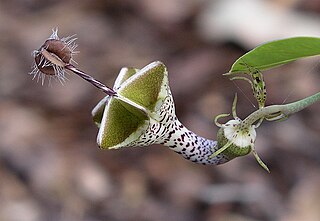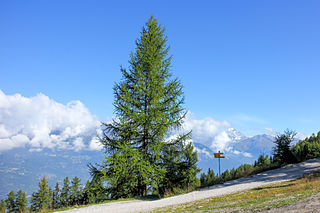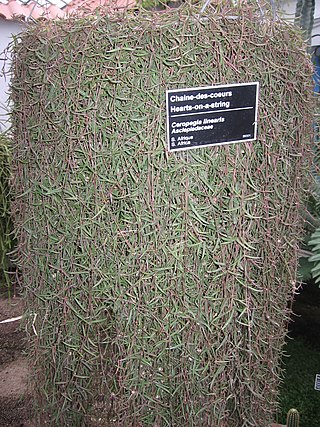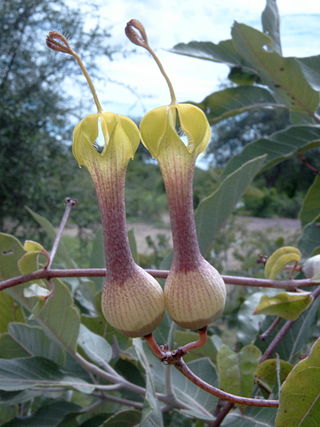
Ceropegia is a genus of plants within the family Apocynaceae, native to Africa, southern Asia, and Australia. It was named by Carl Linnaeus, who first described this genus in his Genera plantarum, which appeared in 1737. Linnaeus referred to the description and picture of a plant in the Horti Malabarici as the plant for which the genus was created. In 1753 he named this species as Ceropegia candelabrum. Linnaeus did not explain the etymology but later explanations stated that the name Ceropegia was from the Greek word keropegion κηροπηγɩον. This means candelabrum in Latin, which has a broader range than the modern word - "a candlestick, a branched candlestick, a chandelier, candelabrum, or also lamp-stand, light-stand, sometimes of exquisite workmanship".

Larix decidua, the European larch, is a species of larch native to the mountains of central Europe, in the Alps and Carpathian Mountains as well as the Pyrenees, with disjunct lowland populations in northern Poland and southern Lithuania. It is widely naturalized in Scandinavia. Its life span has been confirmed to be close to 1000 years but is more often around 200 years. It is claimed that one of the larches planted by the second Duke of Atholl at Dunkeld in 1738 is still standing.
Murlen National Park is a national park located in the Champhai district Mizoram in India. The size of the park area is 200 km2 (77 sq mi). The park is situated about 245 km east of Aizawl, and is close to the Chin Hills. It lies north of Lengteng Wildlife Sanctuary in the same district. It covers an area of approximately 100 km2. The tropical, semi-evergreen and sub montane Forests of Murlen are home to a rich variety of flora and fauna. About 15 species of mammals, 150 species of birds, 35 species of Medicinal plants, 2 species of bamboos, and 4 species of orchids so far have been recorded in this Park. In 2012, 36 people were involved in conservation work of Murlen National Park.

Ceropegia woodii is a flowering plant in the dogbane family Apocynaceae, native to South Africa, Eswatini and Zimbabwe. It is sometimes treated as a subspecies of the related Ceropegia linearis, as C. linearis subsp. woodii. Common names include chain of hearts, collar of hearts, string of hearts, rosary vine, hearts-on-a-string, and sweetheart vine.

Decidualization is a process that results in significant changes to cells of the endometrium in preparation for, and during, pregnancy. This includes morphological and functional changes to endometrial stromal cells (ESCs), the presence of decidual white blood cells (leukocytes), and vascular changes to maternal arteries. The sum of these changes results in the endometrium changing into a structure called the decidua. In humans, the decidua is shed during childbirth.

Capparis decidua, commonly known as karira, is a useful plant in its marginal habitat.

Ilex decidua is a species of holly native to the United States.
Ceropegia aridicola is a species of plant in the family Apocynaceae. It is endemic to China.
Ceropegia dinteri is a species of plant in the family Apocynaceae. It is endemic to Namibia. Its natural habitats are subtropical or tropical dry shrubland and rocky areas.

Ceropegia elegans is a plant species that belongs to the genus Ceropegia. It is endemic to India and Sri Lanka.

Ceropegia linearis is a species of flowering plant in the family Apocynaceae, native to Southern Africa.

Ceropegia candelabrum is the type species in its genus of plants, belonging the subfamily Asclepiadoideae. The Latin specific epithet candelabrum is derived from the candelabra-like appearance of the inflorescences.

Ilex longipes, commonly called the Georgia holly, is a species of plant in the holly family. It is native to the southeastern United States, where it has a patchy distribution. It is typically found in upland forests.
Ceropegia huberi is a species of plant in the family Apocynaceae.
Ceropegia anjanerica is a species of flowering plant in the family Apocynaceae. Flowers are 2.5-3.5 cm long, usually slightly curved and greenish yellow in color and the plants are up to 20cm high. It is endemic to the Anjaneri Hills area of Nashik district.

Ceropegia radicans is a species of herb in the family Apocynaceae. The leaves are fleshy and glabrous and it has a large cage-like flower with a slender tube swollen at the base, and divided into five segments at the top. It grows up to 20cm in height.

Ceropegia rhynchantha is a species of plants in the family Apocynaceae. It occurs in West Africa and has slender flowers, with basal inflation and slight expansion of the tube towards the mouth, as well as relatively long, narrow lobes.
The Andesite Mountain Bushveld is a type of sub-tropical woodland ecoregion of Southern Africa. It is part of the Bushveld biome, which straddles the Tropic of Capricorn and constitutes the southern part of the Zambezian region.












